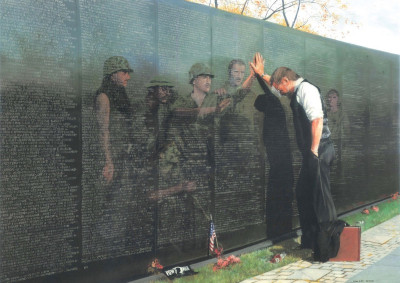35. May We Never Forget Our Veterans
Located: 3rd floor west alcove extension outside Courtrooms 1 and 2
Print in courthouse exhibit: "Reflections" (Lee Tater). The print, provided by VVA Veterans Chapter 172, portrays a man with his hand against the black granite wall. He doesn't see names on the wall. He sees faces. He sees a past that never leaves him.
From the local colonial militias and the Continental Army, which drove the British out of Boston during the American Revolution, to those who served in this era’s engagements in the Middle East, American military personnel have taken up arms to defend the core principles upon which our nation was founded. Since 1776, over 50 million brave men and women have served in the Armed Forces of the United States. Unfortunately, nearly 1.3 million of them have lost their lives in military service. A similar number have suffered combat injuries, often grave in scope.

May we Never Forget our Veterans
From the local colonial militias and the Continental Army, which drove the British out of Boston during the American Revolution, to those who served in this era’s engagements in the Middle East, American military personnel have taken up arms to defend the core principles upon which our nation was founded. Since 1776, over 50 million brave men and women have served in the Armed Forces of the United States. Unfortunately, nearly 1.3 million of them have lost their lives in military service. A similar number have suffered combat injuries, often grave in scope.
In the waning days of the Civil War, by far our nation’s costliest in terms of American casualties, President Abraham Lincoln delivered his Second Inaugural Address. With sad but firm conviction, Lincoln aptly conveyed the solemnity of the war’s expected conclusion, and paid tribute to its veterans on both sides: “Let us strive on to finish the work we are in, to bind up the nation’s wounds, to care for him who shall have borne the battle and for his widow and his orphan, to do all which may achieve and cherish a just and lasting peace among ourselves and with all nations.” A century later, this statement inspired the motto for the United States Department of Veterans Affairs: “To care for him who shall have borne the battle and for his widow and his orphan.”
Our Armed Forces’ unified dedication to a “just and lasting peace” is a foundation of strength for our nation and for the cause of democracy around the world.
As American citizens, we owe our sincere respect and gratitude to the veterans whose unfailing devotion to both our national defense and our international obligations has upheld and sustained our way of life.
The nation’s commitment to properly prepare, equip, and forever care for all members of the Armed Forces of the United States must always be honored. Their many sacrifices for our safety and for the preservation of this nation constitute a debt that can never be fully repaid.
To our Veterans who have Sacrificed Much to Protect our Freedoms and Democracy, and to their Families who Bear the Unseen Scars of that Commitment…
THANK YOU
In memory of those who served In honor of those who serve us now
A note about the exhibit: In perhaps the best-known poem of World War I, Dr. John McCrae observed poppies growing between the crosses on the soldier's graves. It inspired him to write the poem "In Flanders Fields." The poppy has since become known as "The Flower of Remembrance" and is worn in memory of our veterans.
The exhibit also displays a Service Banner. This tradition dates back to World War I when mothers would hand stitch these banners for their windows to signify that a loved one had gone to fight in the war. This tradition encountered a huge resurgence in World War II and again during the Korean War.







